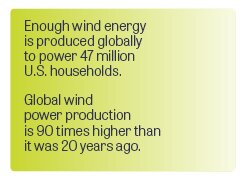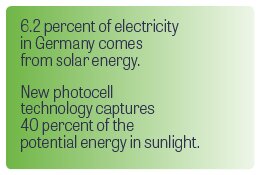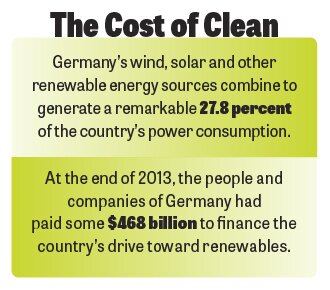Will We Ever Master Clean Energy?
During a blustery time this past July, wind turbines in Denmark produced 140 percent of the country’s national energy needs. The Danes pumped the surplus into the power grids of Germany, Norway and Sweden.
“It shows that a world powered 100 percent by renewable energy is no fantasy,” said Oliver Joy, a spokesman for the European Wind Energy Association. “Wind energy and renewables can be a solution to decarbonization.”
The world has made electrifying progress recently in edging away from fossil fuels and learning to harness the power of clean, renewable energy sources.
Over the past 20 years, global wind-generated power soared more than 9,000 percent, from 5.6 billion kilowatt hours per year all the way up to 520 billion. That equates to the annual energy consumption of 47 million United States households.

We have also made radiant advances in capturing solar power. Germany continues to lead the charge in solar-energy generation, and in 2014 it attained 35.5 gigawatts of installed photovoltaic solar energy capacity. That was enough to generate 6.2 percent of the nation’s total power for the year. Also in 2014, Australian scientists achieved a record in solar efficiency, converting over 40 percent of sunlight that hit test panels into electricity. The average solar panel in use today converts only 15 percent.
We are also advancing in our abilities and efficiencies in tidal power, radiant energy, geothermal power, biomass energy, wave power and hydroelectricity.
Several less-conventional approaches are also showing promise: A team of Swedish researchers is close to making “biological fuel cells” by extracting fluorescent protein from a glow-in-the-dark jellyfish. A French company is developing a system to capture body heat from commuters traveling through the Pompidou train station and pump it through the vents of a nearby apartment complex for heating. Scientists at Melbourne’s Monash University have invented an “artificial leaf,” which they say could one day power the world by using photosynthesis. A dance club in the Netherlands called “Club Watt” powers its light shows by using revolutionary “piezoelectric” material to capture vibration energy from people walking and dancing on its floors. In 2012, a group of Nigerian teenagers developed a generator that can provide up to six hours of power on one liter of urine, a potentially invaluable resource for off-the-grid homes in rural Africa.

These ventures represent some astounding progress in the quest to harness the power of renewable, clean energy sources. But when we take an honest look at the big picture, we realize all too well that it’s still too soon to seal off all the coal mines and power down the oil rigs.
Low Voltage, High Buckage
Even after the massive advances of recent years, wind power still supplies only 2.5 percent of total global electricity consumption. Solar energy provides about 1 percent.
And in nations where wind, sun and other renewables provide higher percentages of power, energy bills are significantly higher.
Germany is viewed as a case study for success. From Brandenburg to Rhineland-Palatinate, solar panels top the roofs, and wind turbines stud the horizons. Altogether, Germany’s wind, solar and other renewable energy sources combine to generate a remarkable 27.8 percent of the country’s total power consumption.
But rewiring the fourth-largest economy on the globe has not come inexpensively. Massive government subsidies have financed Germany’s historic shift, and Berlin passes the costs along to taxpayers and consumers. Over the past five years, average electricity prices for German companies have jumped 60 percent. Residential prices more than doubled from 18 cents per kilowatt-hour in 2000 to more than 37 cents in 2013. By comparison, the average price in the U.S. is 12 cents per kilowatt-hour.
At the end of 2013, the people and companies of Germany had already paid some $468 billion to finance the country’s drive toward renewables. A government estimate says that by the end of 2030, total costs will exceed $1.34 trillion.

In a global economic system built on selfish competition, this is a serious concern. The trend has already prompted several major firms—such as Basi Schöberl GmbH, basf se and sgl Carbon—to relocate some operations out of Germany and into Asia or the U.S. where power is cheaper. Others are poised to follow suit.
Daniel Yergin, vice chairman of the ihs research company, warned that Berlin’s trend toward renewables is not economically sustainable. “Germany’s current path of increasingly high-cost energy will make the country less competitive in the world economy, penalize Germany in terms of jobs and industrial investment, and impose a significant cost on the overall economy and household income,” he said.
Kurt Bock of chemical manufacturer basf se said, “German industry is going to gradually lose its competitiveness if this course isn’t reversed soon.”
A 2014 survey by PricewaterhouseCoopers and the Federation of German Industry said almost 75 percent of Germany’s small- and medium-size industrial businesses view rising energy costs as a major risk to their ability to remain competitive.
For this reason, U.S. Sen. Dan Coats, who served as ambassador to Germany, blasted Berlin’s move toward clean energy as a “misguided executive branch overreach and regulatory attack on energy industries.”
Watt Can Store It?
The quest to harness renewable energy runs into another headwind when we try to store the power we collect for later use. In the heat of the day, many solar-powered homes and businesses produce more electricity than they need. But current-generation battery systems are not affordable enough or efficient enough to reliably store the excess for use at night. That means in the evenings, they have to use expensive batteries or buy electricity to keep the lights on and the fridges cold. The same is true for wind-powered electrical systems that starve for power on calm days.
Utilities with wind or solar farms face the same lack of reliability on a large scale. And coal is the typical go-to when wind and solar systems fail.
Volatile Volts
Renewable energies also destabilize Germany’s power grid. That is because volumes of both wind and sunlight fluctuate wildly. One German grid operator recently told the Institute for Energy Research that the large-scale adoption of renewables has caused a fivefold increase in disruptions to the nation’s power supply.
“[T]he power supply in Germany is no longer secure enough,” said Dr. Klaus Peter Krause of the European Institute for Climate and Energy. “It is even highly vulnerable. A blackout could occur on any given day. Up to now, they have been successful at averting grid collapses by taking lightning speed action, but the number of emergencies has increased massively and is still rising.”
Krause says the problem will have ramifications beyond German borders: “This stability is being sacrificed for no urgent reason and irresponsibly for the sake of the transition to renewable energy, whereby the damage will impact even all of Europe” (Sept. 22, 2014).
And for all our innovation in the science and industry of renewable energy, even the best solar, wind, tidal and biomass installations still consume huge amounts of resources, many of them non-renewable: thousands of acres of land (some of it necessarily deforested), millions of yards of concrete, thousands of miles of steel rebar, thousands of pounds of rare earth metals, millions of tons of batteries, millions of pounds of fiberglass, millions of gallons of paint, millions of gallons of diesel, and thousands of acre-feet of groundwater.
Other environmentally ambitious nations face the same set of problems in their quest to switch to renewable energy sources. Some have ratcheted down their original goals after realizing how economically damaging the pursuit is.
The 5,000- kilowatt question is: Do the clouds hovering over renewable energy mean that it has no economically viable future?
These economic setbacks and technological limitations do not doom the future for renewable power. In fact, the future of clean energy is radiant.
Forecast: Sunny Skies
Imagine a family that owns and operates a large agricultural estate. But this family is different. In each generation, the family members’ overarching goal is not to consume everything they can to increase the comfort of their own lives. Instead, their goal is to improve the estate as much as possible for the benefit of their children. Imagine each generation building upon the labor of the previous one—beautifying that same plot of land, and basing every decision on what will be best in the long term. Imagine this family approaching each project with uncompromising devotion to both function and form.
Now imagine a world in which every family owns such an estate and operates it in that same spirit. These families constitute nations—very unlike the nations of today. Instead of selfishly maneuvering to gain an economic edge over other countries, their goal is to contribute and even sacrifice for the safety, health and prosperity of all countries on Earth. Each family in each country views all others as an extension of its own family, and values the well-being of families in other nations as much as or more than its own.
You might not associate clean energy with the Holy Bible, but this ancient book has a lot to say about this modern issue. In fact, it forecasts what the future of clean energy will be. That may seem unbelievable, but the Bible has been exactly right about its other prophecies: the existence of the United States and Britain, the formation of a united Europe, the creation of a Jewish state, increases in environmental disasters, and the list goes on.
Numerous Bible scriptures foretell of a time in the near future when the kind of family, estate and nation discussed above will populate all the Earth. It says that our most violent form of selfishness—war—will disappear: “[T]hey shall beat their swords into plowshares, and their spears into pruninghooks: nation shall not lift up sword against nation, neither shall they learn war any more” (Isaiah 2:4).
Isaiah 60 says that reports of violence and destruction will disappear; material wealth will spread. Isaiah 51 says that the “waste places” will be comforted.
It also specifies that every family will own its own piece of land. “[T]hey shall sit every man under his vine and under his fig tree; and none shall make them afraid” (Micah 4:4).
Isaiah 35 shows that communities will have infrastructure, possibly quite advanced, but that it will not come at the expense of environmental beauty and health. The effect of this peaceful, beautiful world on the people living in it will be “quietness and assurance” (Isaiah 32:17).
At that future time, the idea of harming the global environment will be unthinkable. There will be no more wasteful plundering of the planet’s natural resources (see Revelation 11:18). All people will work to “dress and keep” and “replenish” the land, as God commanded the earliest humans to do (Genesis 1 and 2). Clean energy sources—possibly including wind, sun, tide, nuclear fusion, Helium 3 and no doubt others not yet even theorized—will replace all sources that pollute. People in the cities of India and China will no longer see the air they breathe.
Perhaps power generation will often be accomplished more at the local level rather than in massive, interconnected grids. Flowing beside every man’s vine and fig tree, maybe there will be streams that turn the blades of efficient turbines. Since droughts and floods will no longer destabilize water systems, such setups could be perfectly reliable.
We don’t know the details, but we know that a spirit of giving will dominate that age. We can be sure that families and nations will work to forsake polluting God’s creation and to generate clean energy. We can be sure that every solution used at that time will make the world better off. Each generation will improve upon the present and leave the planet in better shape for its children. Environmentally—as in every other way—it will be a radiant, clean and wonderful age.

